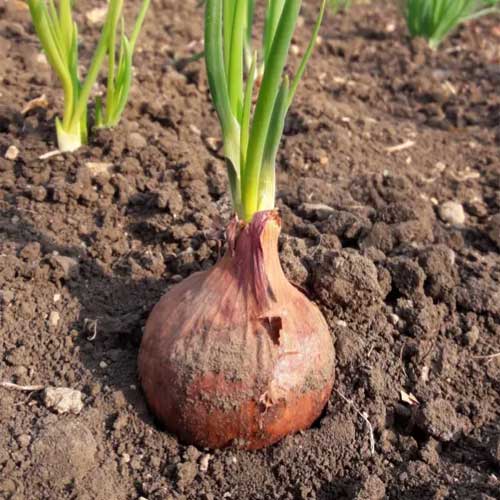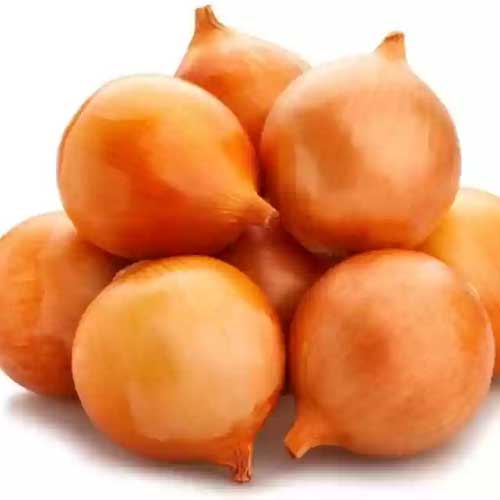Total Number of seeds: 400
Onion Light Red Seeds 🧅✨
Onion Light Red Seeds grow into globular-shaped bulbs with tight skins and a light red color. These onions are ideal for Rabi season cultivation and offer excellent shelf life, making them perfect for storage and market sales. The medium-sized bulbs have a moderate pungency, making them versatile for both raw and cooked uses. This variety is popular in northern India due to its reliable yield and adaptability.
About This Item 🌿
- Type of Seeds: Open Pollinated, Non-Hybrid, Non-GMO
- Germination Time: 6-10 days
- Hours of Sunlight: Needs 6-8 hours of sunlight daily
- Where to Grow: Gardens, raised beds, or pots
- Growing Season: July to November (Rabi season)
- Seeds Sowing Depth: 1/2 inch deep
- Ideal Climate: Cool and dry
- Bulb Shape: Globular
- Size: Medium
- Color: Light red
- Pungency: Moderate
- Days to Maturity: 120-150 days
- Organic Fertilizer Requirement: Apply every 2-3 weeks
- Life Span: Biennial crop grown annually
- Ideal Growing Temperature: 12-25°C
- Harvesting Time: 120-150 days after sowing
- Maintenance Required: Moderate; regular thinning and watering
- Watering Frequency: Keep soil moist but avoid waterlogging
- Ideal Grow Bag Size: 15-18 inches


What Size Grow Bag is Best For Onion Light Red Seeds
Growing Season in India 🇮🇳🌞
Onion Light Red Seeds are best suited for Rabi season planting, with sowing recommended between July and November. These onions develop properly in cool weather, ensuring healthy, medium-sized bulbs with great shelf life.
How to Grow in Pots 🪴
- Choose a Pot: Use a 15-18 inch pot with drainage holes.
- Soil Preparation: Mix loose, well-draining soil with compost.
- Sowing Depth: Plant seeds 1/2 inch deep and cover with soil.
- Sunlight: Place the pot in a spot with 6-8 hours of sunlight daily.
- Watering: Keep the soil consistently moist but not waterlogged.
- Thinning: Thin seedlings to 4-6 inches apart to ensure proper bulb development.
- Harvesting: Harvest bulbs when the tops start to wither and dry.
Seeds Sowing Method 🌾
- Preparation: Use well-draining soil mixed with organic compost.
- Sowing: Plant seeds 1/2 inch deep and space them 4-6 inches apart.
- Watering: Water immediately after planting to maintain moisture.
- Germination: Seeds sprout within 6-10 days.
- Thinning: Thin seedlings once they reach 3-4 inches in height.
Plant Care Tips For Onion Light Red Seeds 🍀
- Sunlight: Provide 6-8 hours of direct sunlight daily.
- Soil: Ensure the soil is well-draining to avoid root rot.
- Fertilization: Use organic fertilizer every 2-3 weeks to promote growth.
- Pruning: Remove yellowing leaves to maintain plant health.
- Pest Control: Monitor for pests like onion thrips and treat with neem oil.
- Disease Prevention: Ensure good airflow to prevent fungal infections.
How to Fertilize Vegetable Plants Effectively
1. Apply Nutrient-Rich Fertilizers
When your plants begin flowering, use nutrient-rich fertilizers like Organic Bone Meal Powder or Vermicompost. This helps in boosting the bloom and enhances overall yield.
2. Use Organic Fertilizers
Feed your plants with organic fertilizers such as Cow Dung Manure or Neem Cake. Organic options promote healthy soil life.
3. Regular Feeding
Apply fertilizers every 20-25 days to ensure plants receive a steady supply of nutrients. Choose from various options like Cocopeat Compost for moisture retention.
Special Features 🌟
Onion Light Red Seeds produce globular, light red bulbs with tight skins and moderate pungency. These onions have an excellent shelf life, making them ideal for storage and market sales. They are popular in northern India, valued for their reliable yield and adaptability to the Rabi season.
Benefits/Uses 🍽️
These onions are rich in vitamins and antioxidants, making them a healthy addition to any meal. They are suitable for use in salads, cooking, and pickling, thanks to their moderate pungency and flavor. Their long shelf life also makes them ideal for bulk storage.
Precautions While Growing ⚠️
- Avoid waterlogging to prevent root rot.
- Thin seedlings early to ensure good bulb development.
- Monitor regularly for pests like thrips to prevent crop loss.
Common Problems Affecting Plants and Solutions 🐛❗
- Pests: Use neem oil to manage thrips and other pests.
- Diseases: Avoid waterlogging to prevent fungal infections.
- Sunburn: Provide partial shade during extreme heat.


Iqbal Hussain
Seedlings sturdy aaye aur colour bright green nikla.
Asha Reddy
Overall plant response was stable and clean.
Rafiq M
The foliage appeared clean and healthy.
Imran
Beej high quality lage, sprouts uniform aaye.
Arvind Mehta
Pyaaz ke paudhe tezi se badh rahe hain aur rang sahi aa raha hai.
Poonam L
Strong sprouts appeared with smooth early progress.
Meena Kapoor
Seedlings grew uniformly with bright green tops.
Tanya
Germination rate strong tha, leaves neat aaye.
Karthik
Growth was consistent and early bulb formation was visible.
Monika Devi
Onion tops clean nikle aur progress smooth rahi.